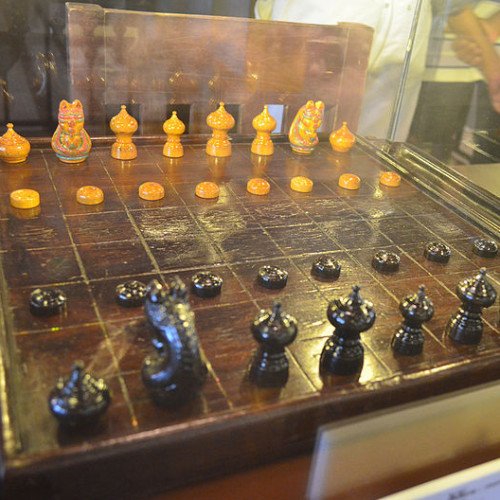MAKRUK VS TANTRIX

MAKRUK
Makruk or Thai chess, is a board game that is descended from the 6th-century Indian game of chaturanga or a close relative thereof, and is therefore related to chess. It is classified as a chess variant. The word "ruk" (Thai: รุก) in Thai is thought to derive from "rukh" which means "chariot" in the Persian language (and is also the common origin of the name for a rook in western chess). The Persian traders came to the Ayutthaya kingdom around the 14th century to spread their culture and to trade with the Thai kingdom. It is therefore possible that the Siamese Makruk, in its present form, was directly derived from the Persian game of Shatranj via the cultural exchange between the two people in this period. This is because the movement of Makruk Thai's queen, or the "seed" (Thai: เม็ด), is essentially the same as the ferz in Shatranj. The disadvantaged player announces the counting of his fleeing moves, starting from the number of pieces left on the board, including both kings. The winning player has to checkmate his opponent's king before the maximum number is announced, otherwise the game is declared a draw. During this process, the count may restart if the counting player would like to stop and start counting again. For example, if White has two rooks and a knight against a lone black king, he has three moves to checkmate his opponent (the given value of 8 minus the total number of pieces, 5). If Black captures a white rook, the count does not automatically restart, unless Black is willing to do so, at his own disadvantage. However, many players do not understand this and restart the counting while fleeing with the king.
Statistics for this Xoptio

TANTRIX
Tantrix is a hexagonal tile-based abstract game invented by Mike McManaway from New Zealand. Each of the 56 different tiles in the set contains three lines, going from one edge of the tile to another. No two lines on a tile have the same colour. There are four colours in the set: red, yellow, blue, and green. No two tiles are identical, and each is individually numbered from 1 through 56. In the multiplayer version of the game, each player chooses a colour, so there are between two and four players. Each draws one tile from the bag, and the person who draws the highest number goes first. Each player then takes five more tiles from the bag, and places all six tiles face up in front of them. The first person plays one tile, usually with their colour on it. Play then rotates clockwise. After playing a tile, each player takes a replacement tile from the bag, so that they always have six in front of them. Tiles played must match the colour of the edges adjoining it. When three tiles surround an empty space so that it is effectively half covered this is called a forced space. If the person whose turn it is has a tile that fills that space they must play it. The player repeats this process until there are no more forced spaces that they can fill, at which stage they make a free move, where they can play any tile as long as they don't breach the three restriction rules given below. Once they have had a free move, they must then fill any more forced spaces that they can. Thus one player's turn can consist of several moves.